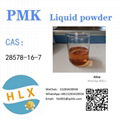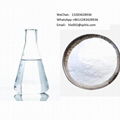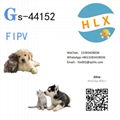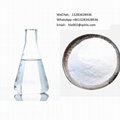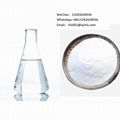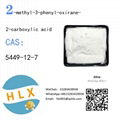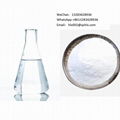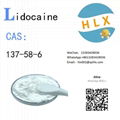| Chemical Properties |
dull yellow powder |
| Chemical Properties |
Anthraquinone is a combustible, light yellow to green crystalline solid. |
| Uses |
bird repellant, irritant |
| Uses |
A precursor for dye formation |
| Uses |
Starting material for the manufacture of dyes; bird repellent. |
| Uses |
Anthraquinone is used in paper industry as a catalyst to increase the pulp production yield and to improves the fiber strength through reduction reaction of cellulose to carboxylic acid. It is also used as a precursor for dye formation. |
| Definition |
A colorless crystalline quinone used in producing dyestuffs such as alizarin. |
| Definition |
anthraquinone: A colourless crystallingquinone; m.p. 154°C. It maybe prepared by reacting benzenewith phthalic anhydride. The compoundis the basis of a range ofdyestuffs. |
| Production Methods |
Anthraquinone is obtained by oxidation of anthracene using sodium dichromate plus sulfuric acid, and is purified by dissolving in concentrated sulfuric acid at 130 °C and pouring into boiling water, whereupon anthraquinone separates as pure solid, and is recovered by filtration. Further purification may be accomplished by sublimation or crystallization from nitrobenzene, aniline or tetrachloroethane. |
| Definition |
ChEBI: An anthraquinone that is anthracene in which positions 9 and 10 have been oxidised to carbonyls. |
| Synthesis Reference(s) |
Journal of the American Chemical Society, 102, p. 1457, 1980 DOI: 10.1021/ja00524a059
The Journal of Organic Chemistry, 29, p. 987, 1964 DOI: 10.1021/jo01027a538
Tetrahedron Letters, 24, p. 5499, 1983 DOI: 10.1016/S0040-4039(00)94122-4 |
| General Description |
Yellow crystals or powder. |
| Air & Water Reactions |
Insoluble in water. |
| Reactivity Profile |
Anthraquinone is incompatible with strong oxidizing agents. |
| Hazard |
Possible carcinogen. |
| Fire Hazard |
Anthraquinone is combustible. |
| Agricultural Uses |
Repellent, Seed treatment: Used as a seed dressing or protectant. Banned in EU. |
| Trade name |
(p)ANTHRAPEL®; FLIGHT CONTROL- PLUS®; HOELITE®; MORKIT®; REPELL® |
| Pharmacology |
Anthraquinone is a secondary repellent and affects birds by causing post-ingestional distress (40). Sometimes, ingestion of anthraquinone-treated food produces vomiting, but often vomiting does not occur and the bird just sits quietly until the discomfort passes. Unlike methiocarb, anthraquinone doe not affect the bird’s nervous system and does not immobilize affected birds. Presumably, the emetic response is produced through irritation of the gut lining, but the actual mechanism is unclear. It is clear, however, that anthraquinone is not a taste repellent or contact irritant. Birds do not hesitate to eat treated food, and they exhibit no sign that treated food is unpalatable to them. The post-ingestional discomfort that results from eating anthraquinone-treated food produces a conditioned aversion to that food type. Birds need to experience the adverse consequences before learning to avoid the protected food. Thus, it is not reasonable to expect losses to cease immediately upon application of the repellent. There will be some level of loss in the crop as the depredating birds acquire the learned avoidance response. |
| Safety Profile |
Moderately toxic by intraperitoneal route. A mild allergen. Mutation data reported. Combustible when exposed to heat or flame. To fight fire, use water, foam, CO2, water spray or mist, dry chemical. When heated to decomposition it emits acrid smoke and irritating fumes. |
| Potential Exposure |
Anthraquinone is an important starting material for vat dye manufacture. Also used in making organics; and used as a bird repellent in seeds. |
| Shipping |
UN3143 Dyes, solid, toxic, n.o.s. or Dye intermediates, solid, toxic, n.o.s., Hazard Class: 6.1; Labels: 6.1-Poisonous materials, Technical Name Required. |
| Purification Methods |
Crystallise anthraquinone from CHCl3 (38mL/g), *benzene, or boiling acetic acid, wash it with a little EtOH and dry it under vacuum over P2O5. [Beilstein 7 IV 2556.] |
| Toxicity evaluation |
Anthraquinone is a stable compound that is virtually insoluble in water. It is not phytotoxic and does not inhibit germination of rice seeds or growth of sprouts. It has very low toxicity to birds and mammals, and it appears to be innocuous to insects as well. There is no known hazard to nontarget species from repellent applications of Flight Control. |
| Incompatibilities |
Incompatible with oxidizers (chlorates, nitrates, peroxides, permanganates, perchlorates, chlorine, bromine, fluorine, etc.); contact may cause fires or explosions. Keep away from alkaline materials, strong bases, strong acids, oxoacids, epoxides |
| Waste Disposal |
Dissolve or mix the material with a combustible solvent and burn in a chemical incinerator equipped with an afterburner and scrubber. All federal, state, and local environmental regulations must be observed. |

